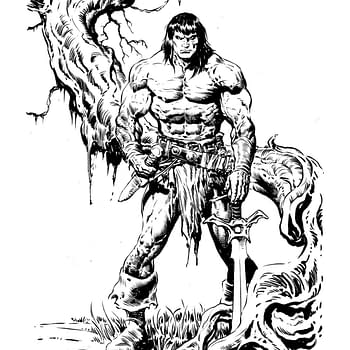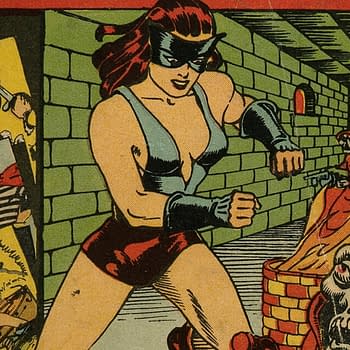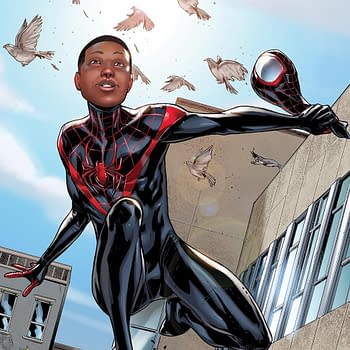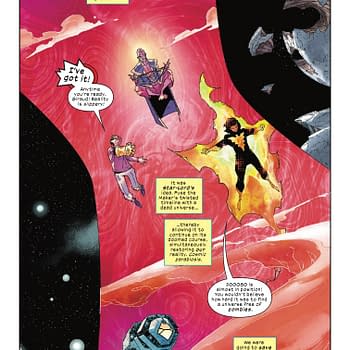Posted in: Comics, Recent Updates | Tagged: alex de campi, Bill Sienkiewicz, colleen doran, Dan McDaid, dark horse, Francesco Francavilla, Frederica Manfredi, gary erskine, igor kordey, richard pace, RM Guerra, Simon Fraser, Smoke and Ashes, Tomer Hanuka
Comics Pyrotechnics – Alex de Campi's Smoke and Ashes Are Together At Last
Alex de Campi and Igor Kordey produced the Eisner nominated-series Smoke from IDW in 2005. Fans wondered if there would be more, and in 2011, de Campi and Jimmy Broxton launched a highly successful Kickstarter for the series' sequel, entitled Ashes. But that was the beginning of the rollercoaster ride, as the production of the new 250 page series moved from a split between de Campi and the original artist to a rallying band of supporting artists including RM Guerra, Colleen Doran, Igor Kordey, Dan McDaid, Richard Pace, Tomer Hanuka, Bill Sienkiewicz, and others. The media buzz over the changeover caught the attention of Dark Horse and together de Campi and the publisher worked out a deal whereby Kickstarter backers would receive a deluxe hardcover with slipcase of both Smoke and Ashes in return for their support. And now, latecomers or the hoi polloi who didn't have the perspicacity to get in on the Kickstarter can finally have the trade Dark Horse collection, too, out today.

Smoke features special forces officer turned assassin Rupert Cain and newbie journalist Katie Shah as they navigate the intrigue of a near-future London rife with dark politics, the machinations of oil billionaires, and, finally, a psychotic cyborg with a penchant for explosives. Ashes picks up five years down the road, with Cain and Katie far from living the dream. Blacklisted, described as terrorists for their takedown of the former government, they both find their rock bottom in poverty and obscurity while they continue to be haunted by impact of their former team-up. Their internal struggles become all too external when their former cyborg nemesis is uploaded to the internet via a military installation and can, quite literally, make their lives hell on earth in revenge.
Though Ashes can be read as a stand-alone 7 chapter arc in the lives of Cain and Katie, with plenty of establishing backstory for the new reader, it's also a story that Smoke demands to be told, which renders its Kickstarter odyssey that much more compelling for readers. Holding the new Dark Horse collection in your hands feels like a embattled but triumphant thing: you finally get to discover in one fell swoop whether Cain and Katie have built a better future for themselves or others, and at what cost.
The multi-artist path to print for Ashes also has a deeply embedded impact on the visual storytelling of the series, resulting in a reading experience that has a uniquely haunting quality. With several artists some issues, the narrative seems to flow and drift into the unexpected with every flip of the page. Because you aren't sure what to expect visually, the series keeps you on your toes and produces sudden, shocking moments of artistic ingenuity in a highly memorable way. You have volleys of pyrotechnics like this, which also seem emblematic of Cain and Katie's unresolved relationship issues:
But also resonant visual and thematic gags from de Campi rendered in relentlessly concrete detail like this:
Yes, that's a woman in a refrigerator a la Gail Simone. It's a page that really should go down in comics history.
But there's also plenty of visually iconoclastic material in this self-defined action series. It's just that this "action series" takes action into highly imaginative and psychological directions you aren't likely to see in other comics. The change up between artists seems to make it even more artistically consistent for de Campi's writing to take sudden turns, particularly into the psychological. One of the most astonishing sequences in the series ventures into the minds of Cain and Katie as they engage with the ghostly cyborg's mind, and it's a free fall into narrative history. Katie's "dream sequence" plunges into the territory of children's books like this:
While Cain's touchstone and interaction with the cyborg's mind finds narrative cognates in illustrated Arthurian tales like this:
These aren't just entertaining artistic explorations, but the canvas upon which the plot continues to play out as Cain and Katie themselves become "characters" for a time in these imagined worlds. When you read all 7 chapters together, particularly, it seems like these sequences help prepare the reader for some of the big ideas and visual shifts that help bring the series to a climactic conclusion in the hands of Bill Sienkiewicz. Sienkiewicz's artwork on chapter 7, and the concepts de Campi brings to bear in the finale of the series, should be recognized as a landmark moment in comics. While these final revelations are very much in keeping with the trajectory of both Smoke and Ashes, they also change your reading of the two series in retrospect and establish just how ambitious an "action" story can be in psychological terms.
And it all happens just beyond this panel:
The collection of Smoke and Ashes has a monumental origin story of its own, and it's a little alarming to think that they might never have existed as a unified narrative without some serious blood, sweat, and tears from de Campi and so many committed artists. Like many creators who see through long and difficult projects, they have seemed to operate under the certainty that these stories simply must be told somehow. Once you've read the first few pages of the collection, you'll suspect that's true, but after finishing the 424 page volume, you'll understand why.
Hannah Means-Shannon is senior New York Correspondent at Bleeding Cool, writes and blogs about comics for TRIP CITY and Sequart.org, and is currently working on books about Neil Gaiman and Alan Moore for Sequart. She is @hannahmenzies on Twitter and hannahmenziesblog on WordPress. Find her bio here.





















